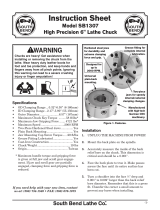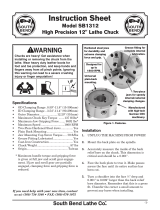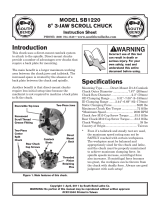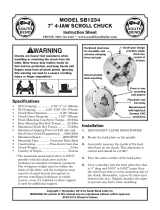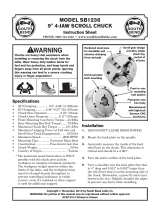Page is loading ...

-1-
If you need help with your new item, contact
us at: (360) 734-1540 • FAX: (360) 676-1075
Chucks are heavy! Get assistance when
installing or removing the chuck from the
lathe. Wear heavy duty leather boots for
foot and toe protection, and keep hands and
fingers away from all pinch points. Ignoring
this warning can lead to a severe crushing
injury or finger amputation!
Model SB1313
High Precision 6" Lathe Chuck
Instruction Sheet
Specifications
• OD Clamping Range ...0.32"-6.30" (8-160mm)
• ID Clamping Range ..2.17"-5.90" (55-150mm)
• Outer Diameter ........................6.57" (167mm)
• Maximum Chuck Key Torque .........58 ft/lbs*
• Maximum Jaw Gripping Force ....... 4721 lbs*
• Maximum Speed .............................2000 RPM
• Two-Piece Hardened Steel Jaws ............... Yes
• Plain Back Mounting ................................. Yes
• Jaw Mounting Cap Screw Torque ......29 ft/lbs
• Grease Fitting Lubricated ......................... Yes
• Cast-Iron Construction .............................. Yes
• Chuck Weight ......................................... 20 lbs
• Origin ................................................... Taiwan
* Maximum handle torque and gripping force
is given at full jaw and scroll gear engage-
ment. If jaw and scroll gear are partially
engaged, clamping force and gripping force is
reduced.
Installation
1. DISCONNECT LATHE FROM POWER!
2. Mount the back plate on the spindle.
3. Accurately measure the inside of the back
relief bore on the chuck. This dimension is
critical and should be ± 0.001''.
4. Face and true the diameter of the back plate.
Make passes across the face until the entire
surface has been cut.
5. Turn a shoulder into the face
1
⁄8'' deep and
0.001" to 0.002'' larger than the back relief
bore diameter. Remember that this is a press
fit. Chamfer the corner a small amount to
prevent any burrs when installing.
Figure 1. Features.
Manufactured
with high-tech
German CNC
machinery
Grease fitting for
complete internal
lubrication
Universal
plain-back
mounting
Four hardened steel jaws
for durability and
extreme clamping
force and grip
Two-piece
jaws for speedy
internal/external
clamping changes
Designed for
up to
2000 RPM

-2-
6. While the back plate is still installed in the
lathe, scribe a 147mm diameter centerline in
the face of the back plate. This centerline is
for the chuck mounting bolt holes.
7. Along the circumference of the centerline
just scribed, mark and center punch the
three mounting bolt hole locations 120°
apart.
8. Remove the back plate from the lathe and
drill three
7
⁄16" diameter mounting holes
completely through the back plate.
9. Clean and stone all mating surfaces until
they are perfectly clean and no burrs exist.
10. Place the chuck in an oven, and then set the
oven to the warm setting. When the oven
reaches approximately 100° F, turn the oven
off and let the chuck sit in the oven for 30
minutes.
11. Place the back plate into a freezer for 30
minutes.
12. Put on insulated leather gloves and place
the chuck on the back plate. Line up the
mounting holes and install the three
supplied hex bolts finger tight.
13. Install the back plate and chuck onto the
lathe.
14. Working in an alternating pattern, tighten
the M10-1.5 chuck mounting hex bolts
until you reach a final torque of 30 ft/lbs.
Alternating the tightening process avoids
chuck warpage.
Operation and Safety
• Chuck Key Safety: A chuck key left in the
chuck can become a dangerous projectile
when the spindle is started. Always remove
the chuck key after using it. Develop a habit
of not taking your hand off of a chuck key
unless it is away from the machine.
•
Disconnect Power: Disconnect the lathe
from power before installing and removing
the chuck or doing any maintenance or
adjustments. Accidental lathe startup can
cause severe injury or death.
•
Secure Clamping: A thrown workpiece may
cause severe injury or even death. When
swapping the chuck jaw positions, use a
torque wrench to re-torque the M8-1.25
jaw mounting cap screws to 29 ft/lbs. When
clamping a workpiece, maximum gripping
force is attained at full jaw and scroll gear
engagement. If the jaw and scroll gear are
partially engaged, clamping force is reduced.
•
Chuck Speed Rating: Exceeding the
maximum rated speed indicated on the
chuck, or using excessive spindle speeds
with an unbalanced workpiece, can cause
the workpiece to be thrown from the chuck
causing a severe impact injury or even death.
Always use the appropriate spindle speed for
the job.
•
Large Chucks: Large chucks are very
heavy and difficult to grasp, which can lead
to crushed fingers or hands if mishandled.
Get assistance when installing or removing
large chucks to reduce this risk. Protect your
hands and the precision ground ways by
using a chuck cradle or piece of plywood over
the ways of the lathe when servicing chucks.
•
Safe Clearances: Often chuck jaws will
protrude past the diameter of the chuck and
can contact a coolant nozzle, tooling, tool
post, or nearby components. Before starting
the spindle, make sure the workpiece and
the chuck jaws have adequate clearance by
rotating the spindle through its entire range
of motion by hand.
6. Remove the back plate from the lathe and
place it on a workbench.
7. Set the chuck on the back plate, and roughly
align the chuck using the alignment set
screws.
8. Use a transfer punch to mark the back plate.
If a transfer punch is not available, a drill
bit of the same size as the mounting holes in
the chuck can be used. Lightly tap on the bit,
rotate it 90° and tap it again.
9. Center punch the marks. Drill and tap the
holes for M10-1.5 threads.

-3-
Care & Maintenance
For optimum performance from your chuck,
follow the maintenance schedule below, and
never hammer on the chuck, jaws, or a workpiece
clamped in the chuck. Never subject the chuck to
abrasives, flame, or water.
Daily:
• Check/correctloosemountingbolts.
• Use a vacuum, rag, or brush to clean the
chuck after use. Never use air pressure to
clean chips away from a chuck.
• Wipe the chuck down with a thin coat of way
oil to prevent surface rust.
• Greasethechuckttingwithonetotwo
pumps of NLGI #2 grease.
If the chuck ever becomes stiff to operate, it may
have been contaminated with metal chips or
abrasives from neglect or poor service practices.
The chuck must be dissembled, cleaned, and re-
lubricated.
To disassemble the chuck for a full cleaning
and lubrication service:
1. DISCONNECT LATHE FROM POWER!
2. Mark the chuck and the mounting plate
where they mate to ensure that when
reassembled both halves line up. Next,
unbolt the chuck and separate both halves.
3. Insert and rotate the chuck key
counterclockwise until the scroll-gear has
released all three jaws.
4. Using a 4mm and 6mm hex wrench, a #1
standard screwdriver, and a ratchet with a
7mm socket, start at #1 and disassemble the
chuck in the sequence shown in Figure 2.
Always disconnect
machine from power before
performing maintenance or
serious personal injury may
result.
!
5. Using mineral spirits, clean and dry all
components. Inspect all bores, teeth, pins,
and mating surfaces for wear, burrs, galling,
rust, or cracks.
6. Without changing the dimension of any part,
use a wire brush, emery cloth, or dressing
stones, to remove any rust, burrs, or high
spots caused by galling.
7. Coat all parts with any automotive NLGI #2
grease, and carefully reassemble the chuck
in the reverse order shown in Figure 2.
8. Rotate the chuck key clockwise until you
see the tip of the scroll-gear lead thread just
begin to enter jaw guide #1.
9. Insert jaw #1 into jaw guide #1, and hold the
jaw against the scroll-gear.
10. Rotate the chuck key clockwise one turn to
engage the tip of the scroll-gear lead thread
into the jaw. Pull the jaw; it should be locked
into the jaw guide.
11. Install the other jaws in the same manner,
and install a new grease fitting if the ball or
nipple leak grease.
12. Line up the timing mark on the chuck and
the mounting plate, and fasten both halves
by tightening and torquing the fasteners as
outlined in Step 13 in Installation.
2
3
6
4
5
1
Figure 2. Chuck sequence of disassembly.
7
Note: Each jaw is marked
1, 2, 3, or 4 to correspond
to its marked slot in the
chuck

-4-
Copyright © March, 2010 By South Bend Lathe Co.
WARNING: No portion of this manual may be reproduced in any shape or form
without the written approval of South Bend Lathe Co.
#CR12664 Printed in Taiwan.
www.southbendlathe.com
Troubleshooting
If you need replacement parts, or if you are unsure how to do any of the solutions given here, feel free
to call us at (360) 734-1540.
Symptom Possible Cause Possible Solution
The chuck has
hard spots or binds
completely.
1.
Jaw is in wrong position.
1.
Reinstall jaws in correct order and position on scroll
gear.
2.
Lack of lubrication, rust, burrs, or
metal shavings inside of chuck.
2.
Disassemble, de-burr, clean, and lubricate chuck.
3.
Broken tooth on the pinion or the
scroll gear.
3.
Disassemble, replace broken parts if possible, and
reassemble chuck.
The workpiece slips
in the jaws.
1.
Incorrect jaw or workpiece clamping
position.
1.
Reposition jaws and workpiece for maximum scroll
gear and jaw engagement is achieved.
2.
Insufficient pinion and scroll gear
torque.
2.
Tighten chuck key to 65 ft/lbs.
3.
Cutting overload.
3.
Reduce cutting depth or feed rate.
4.
Chuck is binding before full
clamping is achieved.
4.
Disassemble and service/rebuild chuck.
Clamping accuracy
is poor.
1.
Workpiece is improperly clamped or
jaw is loose or incorrectly seated.
1.
Remove jaws, clean, de-burr, and re-install with jaw
mounting caps crews torqued to 29 ft/lbs.
2.
Chuck loose, mounting is off center,
or it is improperly seated.
2.
Remove chuck, clean and de-burr mounting, and re-
install, or machine a new mounting plate.
1
13
12
11
8
9
7
4
3
5
2
15
14
6
REF PART # DESCRIPTION
1 PSB1313001 GREASE FITTING
2 PSB1313002 TOP JAW
3 PCAP115M BUTTON HD CAP SCR M6-1 X 16
4 PSB1313004 BACK COVER
5 PSB1313005 LOCK PIN
6 PSB1313006 PINION
7 PSB1313007 SCROLL GEAR
8 PSB1313008 CHUCK KEY W/SPRING
9 PSB1313009 COMPRESSION SPRING
11 PCAP172M CAP SCREW M8-1.25 X 20 BLK C12.9
12 PAW08M HEX WRENCH 8MM
13 PSB1313013 BOTTOM JAW SET OF 4
14 PSB1313014 CHUCK BODY
15 PB174M HEX BOLT M10-1.5 X 35 BLK C12.9
Parts Diagram Parts List
Please Note: We included this breakdown for service purposes only. Since many of the parts shown are machined to each
individual chuck, they are not available as replacement items.
/
